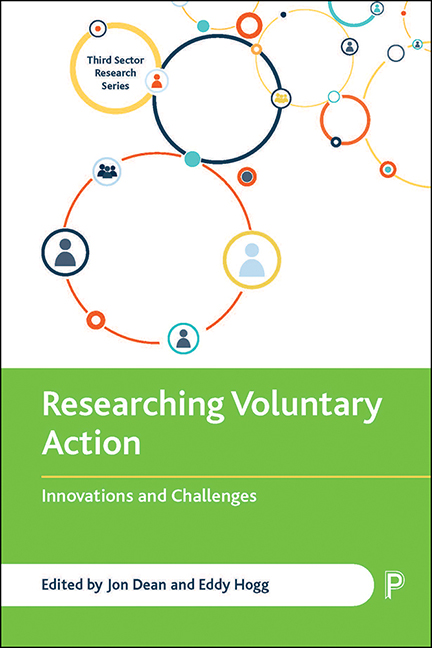Book contents
- Frontmatter
- Contents
- List of figures, tables and boxes
- Notes on contributors
- Acknowledgements
- Series editor’s foreword
- 1 Introduction
- 2 (Un)suitable methods and reflexive considerations: an interview and focus group study of youth volunteering
- 3 Interpretive ethnography: a UK charity shop case study
- 4 Collaborative philanthropy and doing practically relevant, critical research
- 5 Peer research: co-producing research within the context of voluntary and community action
- 6 Charity advertising: visual methods, images and elicitation
- 7 Using archives and objects in voluntary action research
- 8 Using Mass Observation as a source of qualitative secondary data for interdisciplinary longitudinal research on voluntary action
- 9 Investigating meanings and messages on volunteering through television media
- 10 Annual reporting in voluntary organisations: opportunities for content analysis research
- 11 Researching risk in the voluntary sector: the challenges and opportunities of regulatory data
- 12 Exploring the benefits of volunteering: combining survey and administrative data in the Nordic ‘laboratory’
- 13 Spatial approaches to the voluntary sector
- 14 Restudies, surveys and what counts as volunteering
- 15 Conclusion
- References
- Index
10 - Annual reporting in voluntary organisations: opportunities for content analysis research
Published online by Cambridge University Press: 15 September 2022
- Frontmatter
- Contents
- List of figures, tables and boxes
- Notes on contributors
- Acknowledgements
- Series editor’s foreword
- 1 Introduction
- 2 (Un)suitable methods and reflexive considerations: an interview and focus group study of youth volunteering
- 3 Interpretive ethnography: a UK charity shop case study
- 4 Collaborative philanthropy and doing practically relevant, critical research
- 5 Peer research: co-producing research within the context of voluntary and community action
- 6 Charity advertising: visual methods, images and elicitation
- 7 Using archives and objects in voluntary action research
- 8 Using Mass Observation as a source of qualitative secondary data for interdisciplinary longitudinal research on voluntary action
- 9 Investigating meanings and messages on volunteering through television media
- 10 Annual reporting in voluntary organisations: opportunities for content analysis research
- 11 Researching risk in the voluntary sector: the challenges and opportunities of regulatory data
- 12 Exploring the benefits of volunteering: combining survey and administrative data in the Nordic ‘laboratory’
- 13 Spatial approaches to the voluntary sector
- 14 Restudies, surveys and what counts as volunteering
- 15 Conclusion
- References
- Index
Summary
Introduction
Across the world, charities and voluntary organisations face increased public expectations of transparency and, perhaps relatedly, increased requirements to file annual reports with regulators. This reporting includes not only financial data, illuminating the financial position and sustainability of these organisations, but also, critically for this sector, a range of (non-financial and narrative) performance information that can help us to evaluate these organisations’ progress towards their missions. In many countries this data has also become more accessible: often publicly available at no cost from regulators and/or other intermediaries.
In this chapter we argue that annual reporting data represents a potential goldmine for researchers seeking to understand the fundamentals of voluntary organisations and the sector at large, especially for organisations registered as charities. We reflect on our own ‘journey’ in researching an article using content analysis of annual reporting data to understand international regulatory approaches. A key aspect of that journey involved building on past research in the area for our research design. In this chapter we use this example and other recent research to highlight opportunities and challenges for further research.
We use the term content analysis loosely to cover a range of analysis types of information that may take a variety of forms, including quantitative and qualitative information. This chapter does not seek to redefine content analysis – the following sections demonstrate that the term is used quite broadly in prior research. Content analysis is widely used in for-profit (‘capital market’) studies, with researchers often utilising large databases and statistical methods to search for explanations of cause and effect. We show how similar methods have been replicated in the voluntary sector by researchers using mandatory regulatory (often financial) data to answer a range of questions on matters as diverse as performance, governance, regulation and organisational practices. We also show how smaller-sample content analysis has been used to explore what charities report (financial and non-financial), and, when such reporting is voluntary (as is often the case for performance information), why they have reported in this way, and the implications of this. As this book highlights innovations in voluntary sector research, we focus on relevant studies published in accounting and voluntary sector journals in the decade since 2010.
- Type
- Chapter
- Information
- Researching Voluntary ActionInnovations and Challenges, pp. 110 - 121Publisher: Bristol University PressPrint publication year: 2022

